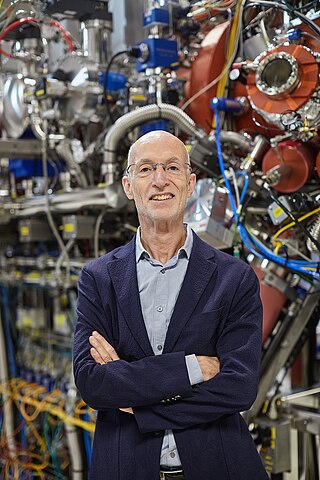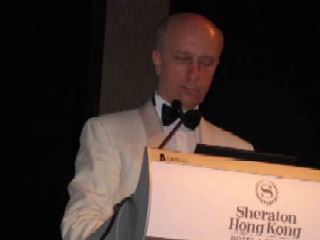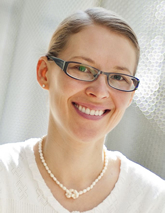Related Research Articles

Nick Holonyak Jr. was an American engineer and educator. He is noted particularly for his 1962 invention and first demonstration of a semiconductor laser diode that emitted visible light. This device was the forerunner of the first generation of commercial light-emitting diodes (LEDs). He was then working at a General Electric research laboratory near Syracuse, New York. He left General Electric in 1963 and returned to his alma mater, the University of Illinois at Urbana-Champaign, where he later became John Bardeen Endowed Chair in Electrical and Computer Engineering and Physics.

Eli Yablonovitch is an American physicist and engineer who, along with Sajeev John, founded the field of photonic crystals in 1987. He and his team were the first to create a 3-dimensional structure that exhibited a full photonic bandgap, which has been named Yablonovite. In addition to pioneering photonic crystals, he was the first to recognize that a strained quantum-well laser has a significantly reduced threshold current compared to its unstrained counterpart. This is now employed in the majority of semiconductor lasers fabricated throughout the world. His seminal paper reporting inhibited spontaneous emission in photonic crystals is among the most highly cited papers in physics and engineering.
Sir Mark Edward Welland, is a British physicist who is a professor of nanotechnology at the University of Cambridge and head of the Nanoscience Centre. He has been a fellow of St John's College, Cambridge, since 1986 and started his career in nanotechnology at IBM Research, where he was part of the team that developed one of the first scanning tunnelling microscopes. He was served as the Master of St Catharine's College, Cambridge and took up office from 2016 to 2023.

Stuart Stephen Papworth Parkin is an experimental physicist, director at the Max Planck Institute of Microstructure Physics in Halle and an Alexander von Humboldt Professor at the Institute of Physics of the Martin-Luther-University Halle-Wittenberg.

Nader Engheta is an Iranian-American scientist. He has made pioneering contributions to the fields of metamaterials, transformation optics, plasmonic optics, nanophotonics, graphene photonics, nano-materials, nanoscale optics, nano-antennas and miniaturized antennas, physics and reverse-engineering of polarization vision in nature, bio-inspired optical imaging, fractional paradigm in electrodynamics, and electromagnetics and microwaves.

Adam Waldemar Skorek is a Canadian University professor and a Polish engineer. He was born in Krzczonów, Lublin, Poland.
Ilesanmi Adesida is a Nigerian American physicist of Yoruba descent. He has been the provost at Nazarbayev University in Astana, Kazakhstan, from September 2016.
Evelyn L. Hu is the Tarr-Coyne Professor of Applied Physics and of Electrical Engineering at Harvard University. Hu has made major contributions to nanotechnology by designing and creating complex nanostructures. Her work has focused on nanoscale devices made from compound semiconductors and on novel devices made by integrating various materials, both organic and inorganic. She has also created nanophotonic structures that might someday facilitate quantum computing.

Ching Wan Tang is a Hong Kong–American physical chemist. He was inducted into the National Inventors Hall of Fame in 2018 for inventing OLED, and was awarded the 2011 Wolf Prize in Chemistry. Tang is the IAS Bank of East Asia Professor at the Hong Kong University of Science and Technology and previously served as the Doris Johns Cherry Professor at the University of Rochester.

Alexander A. Balandin is an electrical engineer, solid-state physicist, and materials scientist best known for the experimental discovery of unique thermal properties of graphene and their theoretical explanation; studies of phonons in nanostructures and low-dimensional materials, which led to the development of the field of phonon engineering; investigation of low-frequency electronic noise in materials and devices; and demonstration of the first charge-density-wave quantum devices operating at room temperature.

Benjamin John Eggleton,, is Pro Vice Chancellor (Research) at the University of Sydney. He is also Professor in the School of Physics where he leads a research group in integrated photonics, nonlinear optics and smart sensors and serves as co-director of the NSW Smart Sensing Network (NSSN).

Supriyo Datta is an Indian–American researcher and author. A leading figure in the modeling and understanding of nano-scale electronic conduction, he has been called "one of the most original thinkers in the field of nanoscale electronics."

Gerhard Klimeck is a German-American scientist and author in the field of nanotechnology. He is a professor of Electrical and Computer Engineering at Purdue University School of Electrical and Computer Engineering.
Andrea Alù is an Italian American scientist and engineer, currently Einstein Professor of Physics at The City University of New York Graduate Center. He is known for his contributions to the fields of optics, photonics, plasmonics, and acoustics, most notably in the context of metamaterials and metasurfaces. He has co-authored over 650 journal papers and 35 book chapters, and he holds 11 U.S. patents.
V Ramgopal Rao is an Indian academic currently serving as the Group Vice Chancellor of Birla Institute of Technology and Science, Pilani for campuses located in Pilani, Dubai, Goa, Hyderabad and Mumbai. He was previously the Director of IIT, Delhi for six years during 2016-2021.
Chennupati Jagadish, an Indian-Australian physicist and academic, is the President of the Australian Academy of Science, and a Distinguished Professor of Physics at the Australian National University Research School of Physics. He is head of the Semiconductor Optoelectronics and Nanotechnology Group which he established in 1990. He is also the Convener of the Australian Nanotechnology Network and Director of Australian National Fabrication Facility ACT Node.
Xu Jianbin is the Choh-Ming Li Professor of Electronic Engineering and director of the material research center at The Chinese University of Hong Kong (CUHK). He is also a Distinguished Research Fellow at the Shenzhen Institutes of Advanced Technology, one of the Chinese Academy of Sciences.

Deji Akinwande is a Nigerian-American professor of Electrical and Computer Engineering with courtesy affiliation with Materials Science at the University of Texas at Austin. He was awarded the Presidential Early Career Award for Scientists and Engineers in 2016 from Barack Obama. He is a Fellow of the American Physical Society, the African Academy of Sciences, the Materials Research Society (MRS), and the IEEE.

Alexandra Boltasseva is Ron And Dotty Garvin Tonjes Distinguished Professor of electrical and computer engineering at Purdue University, and editor-in-chief for The Optical Society's Optical Materials Express journal. Her research focuses on plasmonic metamaterials, manmade composites of metals that use surface plasmons to achieve optical properties not seen in nature.
Shanhui Fan is a Chinese-born American electrical engineer and physicist, with a focus on theoretical, computational and numerical aspects of photonics and electromagnetism. He is a professor of electrical engineering, and a professor of applied physics at Stanford University. He is the director of the Edward L. Ginzton Lab and Senior Fellow at the Precourt Institute for Energy.
References
- ↑ Article "Canada's top honor for Guyanese-born professor". Indo Caribbean World. August 16, 2006.
- ↑ "Archived copy" (PDF). Archived from the original (PDF) on 2020-03-19. Retrieved 2008-06-26.
{{cite web}}: CS1 maint: archived copy as title (link) - ↑ "Engineering professor receives academic excellence award". McMaster Daily News. June 2, 2008. Archived from the original on May 21, 2011. Retrieved April 13, 2011.
- ↑ "Micro- and Nano-Systems Lab receives $4.25 million from Ontario Research Fund". McMaster Daily News. May 11, 2007. Archived from the original on May 19, 2007. Retrieved March 6, 2008.
- ↑ See article "Dr. Deen bags Canada's top engineering honor". Indo Caribbean World. July 4, 2007.
- ↑ See article in Guyana Chronicle, U.G. top two students, Thursday January 4, 1979 in archives at www.guyanachronicle.com
- ↑ "University of Guyana". Uog.edu.gy. 2015-11-03. Retrieved 2016-01-29.
- ↑ "- LASPAU". Archived from the original on 4 February 2016. Retrieved 29 January 2016.
- ↑ "Fulbright - Bureau of Educational and Cultural Affairs". Archived from the original on 6 November 2012. Retrieved 29 January 2016.
- ↑ "AVS - Home" . Retrieved 29 January 2016.
- ↑ See article Deen, M. Jamal; Thompson, E. D. (1989). "Design and simulated performance of a CARS spectrometer for dynamic temperature measurements using electronic heterodyning". Applied Optics. 28 (7): 1409–1416. Bibcode:1989ApOpt..28.1409D. doi:10.1364/AO.28.001409. PMID 20548671.
- 1 2 "Biography" . Retrieved 29 January 2016.
- ↑ "M. Jamal Deen" . Retrieved 29 January 2016.
- ↑ "Research at McMaster University" . Retrieved 29 January 2016.
- ↑ Edmundo A. Gutierrez-D; Jamal Deen; Cor Claeys (2001). Low Temperature Electronics: Physics, Devices, Circuits, and Applications. Academic Press. ISBN 978-0-12-310675-9.
- ↑ "CMOS RF Modeling, Characterization and Applications". World Scientific. Archived from the original on 20 May 2012. Retrieved 29 January 2016.
- 1 2 Fanfair, Ron (2020). "Canadian scholar elected to the Chinese Academy of Sciences". Sharenews. 42 (19): 2. Retrieved 29 February 2020.
- ↑ Rsc Src Archived July 18, 2011, at the Wayback Machine
- ↑ Professors elected to Royal Society of Canada - Canadian University Press Releases Archived 2008-01-29 at the Wayback Machine
- ↑ "IEEE Canada Newsletter" . Retrieved 29 January 2016.
- ↑ "Engineering Professor Inducted Fellow of The Canadian Academy of Engineering". IEEE Canada Newsletter. IEEE Canada. December 2007. Retrieved April 21, 2011.
- ↑ "Member List". Canadian Academy of Engineering. Archived from the original on July 6, 2011. Retrieved April 21, 2011.
- ↑ Members/Fellows Archived 2008-03-08 at the Wayback Machine
- ↑ "IEEE - The Institute" (PDF). Archived from the original (PDF) on 27 July 2011. Retrieved 29 January 2016.
- ↑ Micronet.news December 2002 Archived 2004-12-26 at the Wayback Machine
- ↑ cittrofimenkov Archived 2007-10-09 at the Wayback Machine
- ↑ "ECS Society Awards". Archived from the original on 2015-07-21. Retrieved 2008-03-06.
- ↑ "AAAS - The World's Largest General Scientific Society -". Archived from the original on 15 January 2014. Retrieved 29 January 2016.
- ↑ "Welcome to the World Innovation Foundation website" . Retrieved 29 January 2016.
- ↑ "APS Fellowship an Engineering First at McMaster". McMaster Daily News. December 22, 2008. Archived from the original on July 17, 2011. Retrieved January 22, 2009.